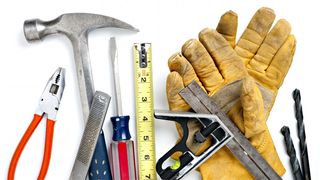If you are creating your own house, the best home design software (opens in new tab) will help you fit in more eco-friendly features during the build. And once you’re done with the frame, use the best interior design software (opens in new tab) to get the perfect look inside.
1. Advanced house framing
Advanced house framing, also known as optimum value engineering, is a specific framing technique wherein a house is constructed using less lumber and waste. Advanced house framing saves energy by using less wood and more insulation. According to the U.S. Department of Energy, using advanced framing can lower material costs by $500 to $1,000 for a 1,200- to 2,400-square-foot house. It can also cut labor costs by 3-5% and annual heating and cooling costs by up to 5%.
2. Cool roofs
Cool roofs are designed to reflect sunlight and lower roofing temperatures. Cool roofs are made from a type of reflective material within roofing materials such as tiles, shingles, paint or other substances. This energy-saving technique is ideal for houses in warm climates where air conditioning costs are high all year around.
3. The right exterior doors
Choosing the right exterior door for a home should be a carefully thought-out decision. When you choose a door, you should first consider the doors’ energy-performance ratings. This score lets you know how well each door does in preserving the energy in your home by trapping heat or cool air inside. Using this score to help you find the ideal door will also help you narrow down your selection and find an exterior door that best matches your taste, needs and wants.
4. Skylights
Skylights are often a feature that enters homeowners’ mind when they think of improving their homes’ energy efficiency. Skylights have many benefits, which makes them ideal for any home. Skylights improve houses’ heating, lighting and ventilation. It is important to note that if you are considering placing skylights in your home, the U.S. Department of Energy recommends they be no larger than 5% of the floor area in rooms with several windows, and 15% of the floor area in rooms with minimal windows.
5. Window treatments
Boring curtains do more than drive your spouse crazy; they can actually help reduce energy costs in your home. By being specific in your choice of window treatments, you can reduce heat loss or keep cool air inside your home. Many factors determine window treatments’ energy efficiency. For example, the type of material and color of the treatment are significant, along with how it opens and closes.
6. Fans
Installing fans throughout your home is an easy way to keep it cool and save you money that you would spend on air conditioning. The best ceiling fans (opens in new tab) come in a wide variety of colors, shapes and styles to match the interior of any home design without looking out of place.
7. Solar panels
Getting solar panels installed on your roof, or even in your grounds, is an expensive initial outlay… but it’ll save you a stack of money on heating or cooling costs, depending on where you live. The energy generated by even a modest solar panel set-up is more than enough to power a home with all manner of appliances and smart-home gadgets. If you’re sticking in a home for a long period of time, definitely consider solar panels. Our guide to the best solar panels (opens in new tab) will help you choose what’s right for you.
8. Exterior colors
The color of your home can greatly contribute to the heat inside it. A light exterior will help the home stay cooler, while a darker color will better maintain heat. The location of the home should be a factor in the home’s exterior design. If it will be located in a warm climate, a light-colored exterior is ideal. In colder climates, darker exteriors are worth considering.
9. Insulation
Insulation is key to maintaining heat in your home. The proper type of insulation, in the right amount, will help trap heat in your home so that you won’t pay unnecessary heating costs. Homeowners have a choice in the type of insulation they place in their homes, but some types are specifically designed for certain areas or types of homes.
10. The right flooring
The type of flooring you choose to place in your home can also save energy and money. Carpet can trap heat and keep your home much warmer during the cold winter months. Rugs can also trap heat in certain areas. Choosing the right flooring for your home is an inexpensive way to save on climate-control costs, particularly if you think carefully about the flooring you choose to install in your home.
